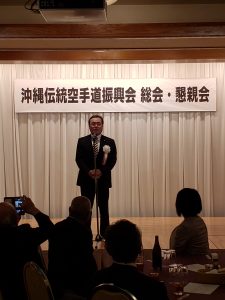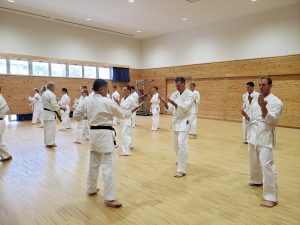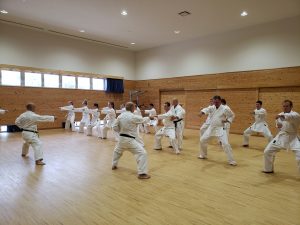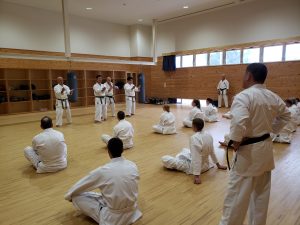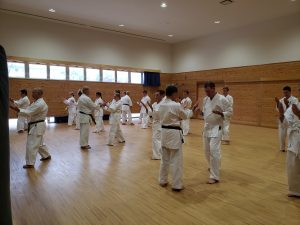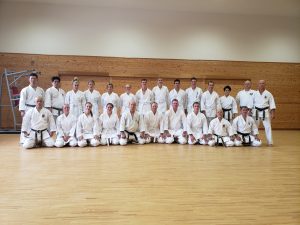Recently, a video regarding karate tourism in Okinawa was featured on NHK World Japan. It showcases a group of foreign visitors training and visiting monuments and the grave of a deceased master.
While such visits are quietly understandable, we feel the necessity to remind visitors that in Okinawa, a grave is the most sacred site for a family and one would normally need the permission to visit the premise.
Usually entering a grave courtyard is not allowed to nonmember of a family. Most families in Okinawa only visit their family tombs during the Shīmī season (1). On this occasion and other special celebrations (death commemoration and anniversary), family members and guests offer sticks of incense to the deceased.
But this is not a proper action nor expected for nonfamily members or students of a karate master. Doing so without the proper authorization from the family can also be seen as disrespectful. Furthermore performing karate kata inside a graveyard is not a good attitude even if the intention was good. For these acts, people would easily be frowned upon by the local society
Please bear this in mind when making a visit to a master’s grave.
(1) Seimei-sai in Japanese language or Shīmī in Okinawan language is a memorial service offered to the deceased. On that occasion, relatives and friends gather in the family grave courtyard. After making offerings in front of the tomb, they enjoy food and drinks in front of the tomb.
Since its establishment in April 2016, the Okinawa Prefecture Government (OPG) Karate Promotion Division has been handling various projects and important work.
During the 2016 fiscal year, a survey on the situation of karate in Okinawa was conducted. It clearly pointed the issues that is facing karate like securing students, the lack of successors, the handling of karate visitors, the low awareness of "the birthplace of karate, Okinawa," and the lack of karate specialists.
After that, in order to strategically pursue efforts to preserve, pass on, and develop karate, which is a traditional culture that Okinawa is proud of, the OPG, karate related organizations, economic circles among others have come together to formulate the “Okinawa Karate Promotion Vision (Overview / Full version)” in March 2018. It depicts a vision of the future to be achieved in 20 years.
The “Okinawa Karate Promotion Vision Road Map (Overview / Full version)” was compiled in March 2019. It is a concrete process for achieving the said promotion vision. Based on this roadmap, the OPG will promote various measures in a systematic and efficient manner, collaborating closely with related parties.
Please accept our apologies as all documents are in Japanese only.
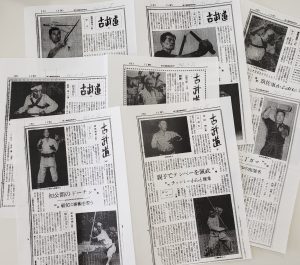
On November 26th, 1961, the Okinawa Kobudō Kyokai (1) held the demonstration called “Dai Ikkai Kobudō Happyōkai” - The 1st Kobudō Demonstration - with the support of the Cultural Property Conservation Committee, the Ryūkyū Shinpō and Okinawa Times newspaper companies. On this occasion, from November 15th to 26th, the Okinawa Times published a series of articles under the title called “Kobudō” introducing 18 martial artists. In the 9 parts of the serial were introduced some famous figures like Kina Shōsei, Nakamura Shigeru, Kaneshima Shinsuke, Chinen Masami, Soken Hōhan, Ishikawa Hōei, Higa Seitoku, Kyan Shin-ei, Kameshima Shin-ei and Nakaima Kenkō among others.
With the permission of the Okinawa Times, we are pleased to introduce the translation of this serial which represents an important piece of legacy for Okinawa karate.
- Okinawa Times - Nov. 9, 1961 “Revival of Kobudō - Kobudō Kyōkai, demonstration on the 26th”
- Okinawa Times - Nov. 15, 1961 Kobudō 1: Kina Shōsei (Sai), Shinjō Heisaburō (Karate-jutsu)
- Okinawa Times - Nov. 16, 1961 Kobudō 2: Irei Matsutarō (Kusarigama), Nakamura Heisaburō (Chisōchin)
- Okinawa Times - Nov. 17, 1961 Kobudō 3: Nakamura Shigeru (Niseshi), Higa Yūsuke (Tinbē)
- Okinawa Times - Nov. 21 1961 Kobudō 4: Kaneshima Shinsuke (Dōchin), Chinen Masami (Sakugawa no kon)
- Okinawa Times - Nov. 22 1961 Kobudō 5: Soken Hōhan (Kusarigama), Shiroma Taisei (Ufutun bō)
- Okinawa Times - Nov. 23 1961 Kobudō 6: Nohara Kamaichi (Shiho kiri), Takara Shigeru (Kiai-justu)
- Okinawa Times - Nov. 24 1961 Kobudō 7: Ishikawa Hōei (Nunchaku), Higa Seitoku (Shōshi no kon)
- Okinawa Times - Nov. 25 1961 Kobudō 8: Kyan Shin-ei (Sai), Kameshima Shin-ei (Naihanchi)
- Okinawa Times - Nov. 26 1961 Kobudō 9: Nakaima Kenkō (Nichō gama), Uchima Anyū (Naihanchi)
- Okinawa Times - Nov. 27 1961 Report on the event
- Ryūkyū Shinpō - Nov. 27 1961 Report on the event
(1) The “Okinawa Kobudō Kyōkai” was founded in 1961. It is not related to the actual Okinawa Prefecture Kobudō Federation. At that time, it was chaired by Higa Seitoku.
(2) Some articles’ translation have already been published on the website of the Okinawa Traditional Karate Liaison Bureau (http://okkb.org/). We are reintroducing these translations with the authorization of the said bureau.
(3) Please note that there may be some errors in the reading of some names. We welcome any suggestions as long as it is provided with corroborative evidence.
The general meeting of the Okinawa Dentō Karatedō Shinkōkai was held on April 27 at the Pacific Hotel, Naha City. As new chairman of the board of directors was elected Arakaki Kunio. A 7th dan Uechi-ryu and student of late Takamiyagi Shigeru, Mr. Arakaki is the present mayor of Kitanakagusuku Village. The former chairman of the board, Kiyūna Chōkō was appointed counselor of the ODKS.
On the left photo is the ODKS chairman, Gorvenor of Okinawa Tamaki Deny. On the right is the new Rijicho, Arakaki Kunio.
OKIC organized the first group training of this new fiscal year.
This first group was from the Australian Defence Force Academy, in Okinawa this April for a study tour of the Battle for Okinawa. During their time on island, they wanted to experience various cultural aspects of Okinawa, specifically to visit the Okinawa Karate Kaikan and experience Okinawa karate.
On April 14th, a group of cadets led by the Okinawa Study Tour officers in charge LTCOL Ross Cable and MAJ Lindsay Adams entered the kaikan. The members of the group, a mix of male and female cadets, changed in karate uniforms and met their instructor for the day, Uechi-ryū karatedō Kenyūkai chairman, Hanshi 9th dan Shinjō Kiyohide sensei. He was assisted by 7 instructors among which masters Shinjō Narihiro and Matsusaki Yoshimitsu.
For 90 minutes, the group was introduced to the specificities of Uechi-ryū that are the kata Sanchin, kihon, bunkai and the conditioning exercises kote-kitae and ashi-kitae.
Finally, the group viewed a demonstration of kata by Kenyūkai Australia Denis Brett sensei, 7th dan and on Okinawa at the time of the event and Shinjō Narihiro sensei. Then instructors Higa Susumu and Kuniyoshi Yōichirō performed yakusoku kumite.
Most of them beginners in karate, the cadets did their best in training and understanding Okinawa karate. According to LTCOL Ross Cable, “it was greatly enjoyed and appreciated by all”.
We would like to thank Evan M. Muxen, historian for Kadena Air Base for assisting in the realization of this project.

